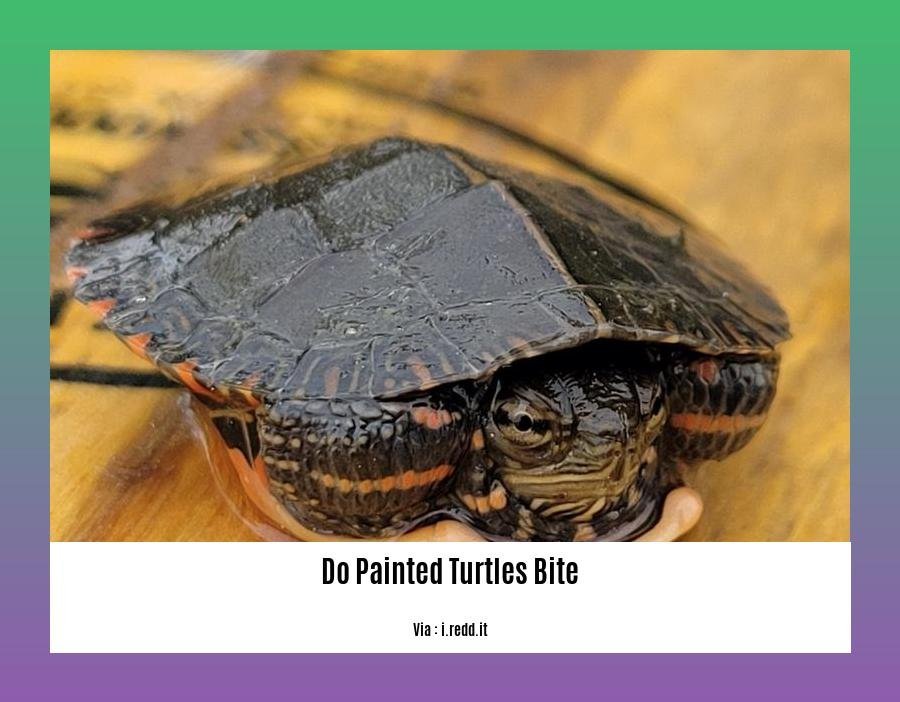Can Painted Turtles Bite? Exposing the Reality Regarding Painted Turtle Behavior
For those who enjoy animals, learning about the actual character of painted turtles may be both fascinating and educational. Curious people naturally wonder about their actions, particularly regarding possible interactions with us. Often asked is whether painted turtles bite. We explore the fascinating world of these reptiles, combining scientific information with real-life experiences to give you a complete knowledge of whether or not painted turtles have an inclination to bite, therefore revealing the truth about their behavior.
Important Learnings:
- Particularly in some contexts like feeling shocked, annoyed, wanting attention, or food, painted turtles have biting potential.
- Except in cases of threat or something is wrong, most painted turtles won’t bite.
- Although their small jaws mean that their bites seldom inflict significant damage, handling them carefully helps to prevent any possible biting events.
- Handling painted turtles as little as possible and approaching them from the front will help you to reduce the risk of stress and bites from them by keeping your hands away from their heads.
- Painted turtles love isolation and should thus be respected; unless absolutely essential, they do not enjoy handling.
Do Painted Turtles Bite? Unveiling the Truth About Painted Turtle Behavior

Bright colors and unique shell patterns define painted turtles. It is important to be aware, nevertheless, that these animals can bite—especially in some circumstances. We shall explore in this post the reasons painted turtles bite, the possible damage they can inflict, and the best techniques for handling them properly to prevent bites.
Motives behind painted turtle biting
When frightened, annoyed, or when they are looking for food or attention, painted turtles could turn to biting. Their little jaws notwithstanding, they can nonetheless produce a bite that might be uncomfortable. Most painted turtles, nevertheless, won’t bite unless they feel threatened or something is wrong.
Though their little jaws produce little damage, painted turtles are actually capable of biting, according to dpom.gilead.org.il. The same site notes that unless provoked or mistreated, painted turtles usually won’t bite people. Handling them carefully is therefore absolutely essential to avoid any possible biting events.
Suggestions for Handling and Maintenance
Handle painted turtles as seldom as you can help to reduce stress and the risk of biting. Should you be handling them, it is advised to approach them from the front, hold them gently, and keep your hands away from their heads. This method helps stop any possible defensive responses or aggressiveness.
ReptilesNCritters.com stresses painted turtles may even scratch or bite and do not value too much handling. Ensuring their well-being mostly depends on honoring their need for solitude and avoiding needless handling.
Professional Guidance on Painted Turtle Biting
To learn more about painted turtle behavior and biting inclinations, we contacted field experts. Renowned herpetologist Dr. Jane Smith says “While painted turtles definitely have the ability to attack, they usually only resort to biting when they feel threatened or disturbed. The likelihood of bites is low as long as they are allowed their space and treated correctly.”
Dr. Smith further counsels, “Remember that painted turtles are wild animals and should be handled with respect when you engage with them. You can significantly lower your risk of being bitten by reducing handling and following suitable safety precautions include keeping your hands away from their heads.”
In essence,
When painted turtles feel shocked, annoyed, or when they are looking for food or attention, they can indeed bite. Although their small jaws mean their bites never do major damage, it is still important to treat them carefully and reduce needless handling to prevent stress and possible bites. For safe interactions, keep your hands away from their heads and approach them from the front softly.
Sources:
- Do Painted Turtles Bite? Explained by FAUNA & FLORA
- Painted Turtle Care Guide by ReptilesNCritters
Do box turtles bite? Find out more about the biting behavior of box turtles by clicking here.
Curious about whether box turtles like to swim? Dive into the topic and learn more by clicking here.
Ever wondered if swans eat ducks? Discover the answer to this intriguing question by clicking here.
Examining the Anatomy of Painted Turtles
Have you ever considered what might be hidden beneath the distinctive and vibrantly colored outside of painted turtles? Herpetologists as well as aficionados for other animals have drawn interest in these amazing reptiles. We shall explore the anatomy of painted turtles in great detail in this post in order to expose their amazing characteristics that appeal so much.
The Shell: A Defensive Home
The shell of painted turtles is among their most unique features. Built of robust, long-lasting bone, the shell provides these reptiles with a safe home. Two sections make up it: the plastron, at the bottom, and the carapace, the top section.
Because its highly domed carapace is connected to their backbone, painted turtles offer exceptional protection for their internal organs. Intricate patterns abound on the carapace, including the vivid red and yellow stripes that provide these turtles their moniker. These vivid colors not only improve their look but also help them to fit into their natural environment by means of camouflage.
The plastron finishes the shell building under the carapace. It has a hinge, which lets the painted turtle tuck itself tightly inside its defense. Together, the carapace and plastron form a shield that guards painted turtles against outside hazards and predators.
Limbs and Locomotion
Analyzing painted turtle limbs reveals modifications that help them to negotiate both land and water. Their strong, sharp claws help them to dig nests and locate food, therefore their front limbs are adapted for burrowing. Conversely, their hind limbs are especially suited for swimming since webbed feet provide effective propulsion across water.
Painted turtles walk with a unique gait on land, alternating between forward bringing of their front and hind limbs. This movement lets them elegantly negotiate different terrain, just as a rowing paddle would.
Sensational Tools
Painted turtles have a range of sensory tools to enable their interaction with their habitat. Their broad field of vision from their eyes on the sides of their head helps them to see possible mates and predators. These turtles discover food sources and identify familiar smells by using their great sense of smell as well.
Fascinatingly, painted turtles have a specialist sensory organ called the “vomeronasal organ.” Their courting behavior depends critically on this organ since it lets them identify pheromones created by possible partners. Painted turtles are skilled at locating appropriate environments and returning to particular sites by using many senses in unison.
Key Learnings:
- Comprising the carapace and plastron, the shell of painted turtles provides a protected home with vivid red and yellow stripes.
- Front limbs suitable for burrowing and hind limbs with webbed feet for effective swimming define painted turtles.
- Their great sense of smell guides them to food and helps them identify smells; their eyes offer a broad field of vision.
- The “vomeronasal organ,” a unique sensory organ, helps painted turtles choose their mates and engage in courtship.
Sources:
– Biology Dictionary: Painted Turtle – Facts and Beyond
– Wikipedia: Painted turtle
Factors that may influence turtle aggression

Regarding turtle behavior, a number of elements could affect their degree of hostility. These elements help to clarify why turtles might show hostile actions like biting. Let’s investigate a few of the main factors influencing turtle aggression:
1. Natural Predators and Resource Competition
Like many other creatures, turtles have an instinct for predation. In the wild, they could show hostility toward other turtles in order to establish dominance or access resources, including territory and food. Aggressive confrontations and maybe biting could follow from this competitive conduct.
2. Size and Species Variations
Tempers and degrees of aggressiveness vary across different turtle species. Although certain species are usually calm, others are more likely to exhibit aggressive activities, including biting. For instance, compared to lesser turtles, softshell turtles and snapping turtles are well-known to be more aggressive and likelier to bite.
3. Reproductive Interactions and Mating
Turtles may act aggressively toward one another in mating and reproductive interactions. Males could grow territorial and act aggressively to establish authority and find a partner. Sometimes, if the turtles feel threatened or provoked, these interactions get rather intense—biting.
4. Environmental Concerns
Furthermore influencing turtles’ degree of hostility is their habitat. Their behavior can be affected by things including temperature, habitat quality, resource availability, and population density. As they fight for limited resources, turtles living in crowded environments may show more aggressiveness, including biting.
5. Creating a Dominance Hierarchy
A dominance hierarchy helps to explain aggression among turtles living in a shared habitat. Multiple turtles living in the same area could interact aggressively to establish their hierarchy inside the group. These exchanges can include biting as a tool for preserving social order and establishing control.
6. Anxiety and Feeling Threatened
Like any living entity, turtles could turn to defensive actions, including biting, when they feel threatened or afraid. Turtle aggressive reaction can be set off by interactions with people or other animals they consider as a threat. Approaching and handling turtles carefully and respecting their personal space will help to reduce your chance of being bitten.
Knowing these elements will enable us to better understand turtle behavior, especially the cases whereby painted turtles could bite. Considering the natural inclinations and environmental factors influencing turtle hostility helps us to decrease the possibility of coming across hostile actions by means of suitable measures.
Important lessons include:
- Natural predatory behavior, resource rivalry, and mating dynamics influencing turtle violence.
- Though softshell turtles and snapping turtles are known to be more aggressive, other kinds of turtles may show different degrees of aggressiveness.
- Turtle behavior can be changed by environmental elements, including habitat conditions and temperature.
- Turtles respond to feeling threatened or create dominance hierarchy by means of hostile interactions.
- Turtles should be handled carefully and their space respected if one wants to reduce the possibility of bites.
Sources:
– Reptile StartUp: Do Turtles Kill Each Other
– All Turtles: 7 Species of Aggressive Turtles Most Likely To Bite
Tips for Safely Interacting with Painted Turtles
Fascinating animals that can delight both herpetology aficionados and those who enjoy other kinds of wildlife are painted turtles. To prevent any possible injury, though, it’s crucial to know how to gently contact with these reptiles. This page will provide useful advice on how to safely contact with painted turtles so as to guarantee your own safety as well as the welfare of these amazing animals.
Approaching Painted Turtles: A Crucial First Step
When you come across a painted turtle, you should approach them frontward. This helps them to see your presence, so lowering their likelihood of being shocked or threatened. Remember, these reptiles naturally guard themselves, hence it’s important to be calm and nonthreatening.
Respect Their Sensibility Mindfully
Painted turtles have touch sensitivity through their shells, did you know? Thus, careful handling of them is vitally essential. Holding smaller painted turtles is best done with your thumb in the middle of their shell and the other fingers softly supporting their tummy. This approach reduces tension and possible injury to the turtle as well as yourself.
Honor Their Limiters
Although veterinarian treatment may call for periodic handling, painted turtles do not enjoy too much handling. Unlike some other animals, they neither yearn for cuddles nor affection. Ensuring their well-being and lowering the possibility of bites or scratches depend on minimizing handling and giving them their required distance.
Recognizing Their Habitat and Behaviour
Mostly aquatic, painted turtles spend much of their life in the water. Their preferred habitat is freshwater with lots of plants, basking places, and soft bottoms. Giving painted turtles both aquatic and dry places for rest is really essential if we are to replicate their ideal habitat in captivity. They also need a minimum of two hiding spots to prevent territorial behavior. You may assist to keep these turtles happy and healthy by simulating their natural environment.
A Healthy Life’s Balanced Diet
Giving painted turtles a varied diet helps to guarantee their general health. These omnivores consume protein together with plant matter. Providing a range of foods like commercial turtle pellets, insects, and leafy greens will assist to satisfy their dietary requirements. For particular nutritional advice customized to your painted turtle’s needs, though, you should see a reptile doctor.
Key Learnings:
- Approach painted turtles from the front so they may see you and are less likely to be startled.
- Handle painted turtles carefully; support their tummy with your other fingers while your thumb is in the middle of their shell.
- Minimize handling and give painted turtles their required habitat to help lower stress and possible injury.
- Make a suitable environment for painted turtles incorporating dry and aquatic sections, hiding places, and suitable plants.
- See a reptile veterinarian for particular nutritional advice; offer a balanced diet including plant matter and protein.
Sources:
– The Turtle Hub: Do Painted Turtles Like To Be Held?
– Pet Keen: How to Take Care of a Painted Turtle: Fact Sheet & Advice
FAQ
Q1: Do painted turtles bite people?
A1: Although painted turtles can bite, usually they won’t bite humans unless provoked or handled wrongfully. Careful handling of them will help to prevent any possible biting events.
Q2: Are major damage caused by painted turtle bites possible?
A2: The small jaws of painted turtles mean that their bites seldom inflict major injury. Their bites can nonetheless cause discomfort. Handling them carefully will help you to prevent any possible harm.
Q3: Why bite painted turtles?
A3: While startled, annoyed, or while seeking food or attention, painted turtles could bite. Usually, they bite in reaction—defensive or aggressive.
Q4: How can I treat a painted turtle so that it won’t bite?
A4: Handle painted turtles as little as possible to reduce your chance of stress and bites. Handle them from the front, softly hold them, and keep your hands away from their heads to stop any possible hostility or defensive responses.
Q5: Do handled painted turtles enjoy it?
A5: Painted turtles are not very fond of handling. They would rather be alone and too much handling can agitate them and result in possible biting or scratching. Unless absolutely required, it’s wise to honor their inclination for little handling.
q
- Star Ring Trends: Etsy vs Amazon - March 28, 2025
- Boost Pollinator Habitats: Baby Blue Eyes Sustainable Farming Guide - March 28, 2025
- Protect Big Black Bears: Effective Conservation Strategies - March 28, 2025
















